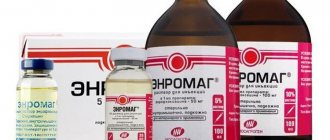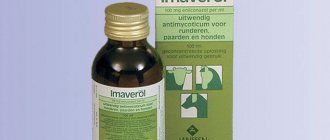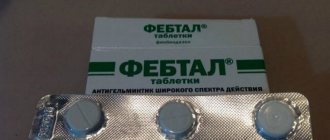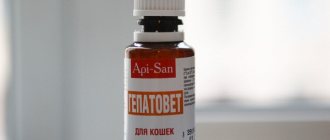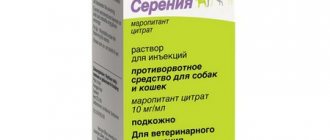Diarcan is a drug for the treatment of diarrhea in cats.
Diarcan is a medication used to treat diarrhea in cats.
Provided that diarrhea is caused by microorganisms such as salmonella, E. coli, shigella, etc.
Below are instructions for using Dirkan for cats. If microorganisms are especially sensitive to sulfaginidine, which is the main substance of the drug Diarcan, the drug exhibits significant effectiveness. Diarkan also contains benzonaphthol and ratania. The active substances of diarcan have a pronounced antiseptic, antimicrobial and anti-inflammatory effect in the body of cats.
This drug is available in the form of sugar cubes, which is very convenient for giving it while feeding the animal. It is slowly absorbed in the intestines of cats, which ensures its long-lasting effect on pathogenic microorganisms. Liquid ratania extract, which is part of diarcan, forms a film on the intestinal mucosa. It protects and helps restore water-salt balance in the intestines. The film also prevents toxins from pathogenic bacteria from entering the body.
Action of Diarkan
The antibiotic agent has an antibacterial effect. The result of use is observed after the pet takes the drug for the first time.
Antibiotic for cats Diarcan was developed by the French
Diarkan has a complex effect:
- prevents the spread of intestinal infection throughout the body;
- destroys pathogens in the affected area;
- restores water-salt imbalance in the pet;
- eliminates vomiting, diarrhea and other signs of intestinal diseases;
- prevents the development of chronic infection.
The medicine contains an extract of plants that have a regenerating and enveloping effect on the walls and mucous membrane of the intestines.
Restoring natural defenses prevents indigestion that occurs due to intestinal disorders.
Instructions for using diarcan for cats
- Diarcan is given to the animal twice a day at the rate of 1/2 cubic meter per 5 kg of live weight of the cat per dose.
So, an animal weighing less than 2.5 kilograms is given 1/4 cubes. - If the cat weighs from 5 to 10 kg, then you can give one cube.
The only side effect of taking the drug may be allergic reactions that occur in hypersensitive animals. A contraindication to taking diarcan is increased individual sensitivity in a cat. This drug should not be given to a cat with severe renal or hepatic impairment.
Analogues of Diarkan
The drug for intestinal infection Diarcan has positive reviews regarding its effectiveness.
Diarcan is used in veterinary medicine for the treatment of gastrointestinal diseases of infectious origin.
However, if there are contraindications or side effects, it may be necessary to replace the product with an analogue. It is also possible to search for a drug with similar pharmacological effects at a lower cost.
Analogues recommended by veterinarians:
- Exekan;
- Pillkan;
- Polyverkan.
Replacement of the drug Diarcan prescribed by a specialist is carried out with the consent of the doctor.
You must first read the instructions to avoid adverse reactions and become familiar with the features of use.
Be sure to read:
Amoxisan for cats: instructions, dosage, how to inject, reviews and price
General information about the drug Diarcan
- According to the instructions, the drug is produced packaged in 8 briquettes in hermetically sealed plastic blisters, packed in cardboard boxes along with instructions for use.
- Active ingredients: sulfaguanidine, benzonaphthol, ratania.
- Diarcan in 1 briquette contains the following active ingredients: sulfaguanidine - 300.0 mg, benzonaphthol - 100.0 mg and ratania extract - 50.0 mg, and sucrose as an auxiliary and formative substance - up to 8 g.
- Diarcan should be stored out of the reach of children.
- Dosage form: briquette for oral administration.
- The medicinal product must not be used after the expiration date.
- Unused drug is disposed of in accordance with legal requirements.
- In appearance, the medicine is a sugar cube with a dividing groove in the middle.
- According to the instructions, the shelf life of the veterinary product “Diarcan”, subject to storage conditions, is 5 years from the date of production.
- Trade name of the veterinary medicinal product: Diarcan (in Latin - Diarkan).
- Store diarcan in the manufacturer's sealed packaging in a dry place, protected from light, at a temperature from 0°C to 25°C.
Composition and release form
The antibiotic for cats Diarcan was developed by a French company that produces drugs for animals.
The composition of the product actively destroys bacteria that cause intestinal disorders.
Diarkan
The main components are substances:
- sulfaguanidine;
- benzonaphthol;
- liquid extract from the ratania plant.
The preparation is produced in a form convenient for use - pinkish briquettes in the form of cubes that dissolve in liquid.
Diarkan is produced in blisters . The package contains eight cubes of the product for oral administration to animals.
Pharmacological properties
Diarcan belongs to the combined antibacterial drugs used for gastrointestinal pathology in cats and other animal species.
Sulfaguanidine is the first active ingredient of the drug "Diarcan"
Sulfaguanidine has antibacterial activity against microorganisms such as:
- coli
- salmonella
Sulfaguanidine, like other sulfonamides, is a competitive antagonist of para-aminobenzoic acid and prevents the formation of tetrahydrofolic acid, which in turn disrupts the formation of purine and pyrimidine bases in the bacterial cell.
When administered orally to cats, sulfaguanidine is practically not absorbed, creating high bacteriostatic concentrations in the intestine.
It is excreted from the body of cats mainly unchanged in feces.
Benzonaphthol is the second active ingredient of diarcan
Benzonaphthol breaks down in the intestines of cats into benzoic acid and 3-naphthol, which have an antiseptic effect, and are excreted in urine and feces.
The third active ingredient of the drug Diarcan is ratania extract
Ratania extract in cats has an enveloping effect and prevents the absorption of toxins into the blood.
In terms of the degree of impact on the cat’s body, Diarcan is classified as a low-hazard substance
(4th class - according to GOST 12.1.007-76).
Dosage
Diarcan is given to animals in the recommended doses indicated in the instructions. The one-time norm is not calculated for each kilogram of weight, but according to average data: cats weighing 1-5 kg - half a briquette; large cats whose body weight is 5-15 kg - 1 cube. It is prohibited to exceed the recommended dosage of the medicine; otherwise, the risk of an allergic reaction, vomiting, and diarrhea increases. Alarming symptoms can be eliminated by gastric lavage and anti-allergenic drugs.
Procedure for administering the drug to domestic cats
Diarcan is used in cats to treat enteritis of bacterial etiology caused by microorganisms sensitive to sulfaguanidine and benzonaphthol.
According to the instructions for use of the drug, Diarcan is contraindicated for use in cases of severe renal and liver dysfunction, urolithiasis, pregnancy, increased sensitivity of cats to sulfonamide drugs, as well as kittens during the suckling period and weighing less than 1 kg.
Diarcan is prescribed to cats and other animals 2 times a day with an interval of 12 hours, in severe cases of the disease - 3 times a day with an interval of 8 hours for 3-5 days in the following doses:
- small cats (1-5 kg) - 1/2 cube
- cats (5-10 kg) - 1 cube
A sugar cube is added to animal feed or drinking water. Cats, as a rule, do not like sweets, so it is necessary to forcefully administer the drug “Diarcan”. To prevent crystalluria during the period of use of the drug, abundant watering is recommended; for this, the cat should be provided with free access to water.
According to the instructions, in case of an overdose of Diarcan, symptoms of dysfunction of the gastrointestinal tract (vomiting, diarrhea) may be observed. In this case, gastric lavage and symptomatic treatment are recommended.
No specific effects of the drug upon its first use and discontinuation were identified.
Contraindications and restrictions
The use of Diarkan by animals suffering from urolithiasis, liver and kidney disorders, pregnant cats, kittens under 1 month of age, as well as cats with hypersensitivity to the components of Diarkan, in particular to drugs of the sulfonamide group, is strictly prohibited.
Signs of adverse reactions from the body will include vomiting, allergies in the form of rashes, and hives. In this case, it is necessary to urgently stop taking the medication and give the animal an antiallergic drug. It is not recommended to combine treatment with Diarcan with taking ascorbic acid, as there is a risk of triggering crystallurgy. This drug is not used to treat cows, goats and other productive farm animals.
Learn about the main antimicrobials in animals
- Yodez
- Vibramycin
- Iodoform
- Iodinol
- Kanamycin
- Uses of iodine
- Iodopyrone
- Potassium permanganate
- Sinulox
- Bactrim
- Ampicillin
- Benzylpenicillin
- Griseofulvin
- Diamond green
- Hexamethylenetetramine
- Tobramycin eye drops
- Natural penicillins
- Nystatin
- Oxacillin
- Neomycin
- Metronidazole
- Furadonin
- Penicillins in veterinary medicine
- Methylene blue
- Ciprovet tablets
- Levofloxacin
- Ciprovet drops
- Amikacin
- Lincomycin
- Imipenem
- Ketoconazole
- Itraconazole
- How to dilute cefazolin?
- Phtazin
- Tobramycin
- Cephalexin
- Amoxicillin in veterinary medicine
- Gentamicin
- Cefazolin
- Enrofloxacin
^Top
Storage conditions
In sealed packaging, the product retains its properties for up to 5 years from the date of production. After opening the blister, the cube must be used within 72 hours. Diarkan should be kept in a dark closet, inaccessible to animals and children. One of the important storage conditions is compliance with the temperature regime (5-25°C). Diarkan is popular among veterinarians and cat breeders due to its convenient form of application and sweetish taste. The treatment process eliminates stressful situations, and this is important for a quick recovery.
How to give medicine to a cat
Visit the profile section of our Medical Examination forum or leave your feedback in the comments below. More opinions means more useful information, it will be useful to someone. If there are good and interesting videos on the topic of the article, write and I will insert them into this publication.
Indications for use
Looking at the effects of the active ingredients of Diarkan, it is not difficult to guess why this drug is used for dogs:
- intestinal infections - unknown etiology, salmonellosis, shigellosis, E. coli;
- diarrhea or vomiting suspicious for infection.
Important! Intestinal infections are always accompanied by loss of fluid, therefore, in addition to antiseptics, the dog needs a lot of fluid: for this, several containers with clean water should be freely available to it.
Cost of Diarkan
It is easy to find Diarcan for dogs in veterinary pharmacies in large cities. Its price depends on the region, on average 600 rubles per package. Sometimes you can buy cubes individually, then for 1 unit you will pay 70 rubles. This is beneficial when treating puppies and small breed pets, since one briquette is enough for two uses.
Analogs of Diarkan are cheaper. Fthalazol and Sulgin are sold in regular pharmacies and cost up to 100 rubles. Their disadvantages are that they do not act on all bacteria and are not adapted for pets, so it is difficult to force pets to swallow the tablet.
Interaction with other drugs
Diarcan can cause crystalluria, especially in combination with certain drugs. Crystalluria is an increase in the concentration of urine, with the formation of oxalate or urate crystals there. Crystals passing through the urinary tract can injure them and cause a bladder or kidney infection.
It is undesirable to combine Diarcan with anticoagulants and non-steroidal anti-inflammatory drugs.
Some drugs increase the acidity of the urine, making crystalluria more likely. These are, for example, ascorbic acid - vitamin C, hexamine, aspirin.
It is not advisable to use Diarcan in combination with:
- anticoagulants;
- sulfonylurea derivatives;
- non-steroidal anti-inflammatory drugs (ketofen).
In order to be neutralized and leave the body, these drugs must bind to blood proteins. Sulfanilamide in Diarkan takes their place in the protein and does not allow it to leave the bloodstream - the toxicity of the drugs listed above increases.

